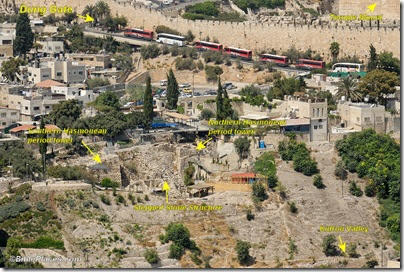|
BiblePlaces Newsletter
Vol 6, #2 -
December 10, 2007
There never was a plan for this newsletter to skip so many months, but time
has been very tight for me all year. I've managed to keep the
BiblePlaces Blog updated, and
to respond to emails, and to make progress on some other projects, but
the newsletter never made it to the top of the "to do" list. My
apologies to any who have been disappointed. An additional factor
occupying my time has been a move from Israel to the U.S. to begin work
on a Ph.D. in Biblical Studies. My intention is to continue the
BiblePlaces website, blog and newsletter even while away from the
Holy Land. I won't have the same first-hand presence, but most of
my reporting before was second-hand anyway. My plan is to continue
to share some outstanding photos, point you to the most important articles related to the biblical
sites, and to deconstruct misleading news reports as necessary.The
featured photos of this newsletter are of "Judah and Jerusalem in the
Snow." In parts of the world, snow may not be something you want
to see at this time of year, but where I'm living in Texas, it was 80
degrees today. These photos were taken over the last 3-4 years,
and I hope you'll find them enjoyable even if you live in a snowy place.
A welcome to new subscribers to the newsletter. There are more
than a thousand who have joined since the last issue. A reminder
to all: if you have a new email address, you can make the switch for
this newsletter easily, by
unsubscribing from your current address, and
subscribing with your new address.
Todd Bolen
Editor, BiblePlaces.com
In Exile in Texas
(On study leave from Israel Bible Extension (IBEX), Judean Hills,
Israel)
News from Israel
 from the BiblePlaces Blog... from the BiblePlaces Blog...
Palace of Queen Helena Found? - Scholars have long known that it
was built in the City of David and now archaeologists claim to have
found it. Maybe...
Gospel of Judas: NG Blew It - Last year National Geographic
created a media circus over a discovery that alleged that Judas didn't
betray Jesus but rather obeyed him. A scholar now says that NG
misread the text and it says nothing of the sort....
Nehemiah's Wall Discovered? - For years, I've had to shrug my
shoulders when students ask where they can see remains of the wall that
Nehemiah built around Jerusalem. Now Eilat Mazar says that she has
found it... (and more
here)
| |
 |
|
| |
Excavations around the alleged
discovery of Nehemiah's wall in the City of David |
|
Muslims Recognize Temple's Existence - No, this is not a new
development, but rather an old one. That is, they used to
believe that it existed, but now they don't. A BiblePlaces reader
dug up the evidence and you can see it for yourself...
Roman street found near Western Wall - Excavations in the
tunnels north of the prayer plaza have revealed a well-preserved side
street that connected to a bridge leading to the Temple Mount...
Carta's New Atlas - If you've been looking for the latest
scholarship from first-rate scholars but didn't want to spend $100 for
The Sacred Bridge, well now you can get 80% of the content for 50% of
the price...
The Pictorial Library: Romanian Edition - The perfect gift for
the Romanian in your life...
Material from First Temple Period Found on Temple Mount - This
is a first - archaeological artifacts from the Old Testament period
uncovered on the Temple Mount in an undisturbed context. Just
don't expect that any more will be found... (and more
here and
here)
And more...
Featured BiblePlaces Photos:
Judah and Jerusalem in the Snow
Snow doesn't fall all that often in the hills around Jerusalem, but when
it does it is a beautiful sight. In the last ten years I've lived
in Israel, we'd get a good snowfall about once every two or three years.
Sometimes it stuck on the ground only a few hours, but other times (such
as the first photo below) it lasted for a few days. I have never
seen more
than one snowfall in a winter. Since people don't know how to
drive in such conditions and snow-clearing equipment is not in great
supply, the best way to see the beauty of the land is to get where
you're going before the storm begins. One time I sat at a
standstill in traffic for an hour when it started to snow. But if
you're at the right place at the right time, you can enjoy a different
kind of beauty than most experience.
Each photo is linked to a higher-resolution
version which may be used freely for personal and educational purposes.
Commercial use requires separate permission. These photos are also
available for download in a
PowerPoint file
(2.1 MB). For more
high-quality, high-resolution photographs and illustrations of biblical
sites, purchase the
Pictorial Library of
Bible Lands or the
Historic Views of
the Holy Land collections. |

